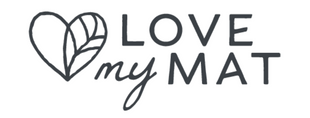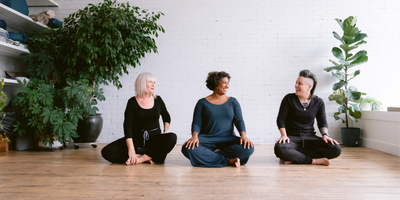Upcycled DIY For Plastic Free July
Happy Plastic Free July! At Love My Mat it is our ethos to create and operate this business as sustainably and mindfully as possible. From the materials we use to make and ship our products, to the way we run and operate in our shop, we are always trying to choose the most sustainable options. This commitment to sustainability extends outside of the company and into the personal lives of each of our staff members in different ways.

What is Plastic Free July?
Plastic Free July is a global movement that provides education around ending plastic pollution, and provides resources to help you live a lower waste lifestyle. This movement challenges individuals for the month of July to take a closer look at the choices we are making, the waste we are producing, and the pollution we are contributing to. This challenge encourages us to shift away from single-use plastics and move toward more sustainable long-term solutions.
Click here to find out more about the global Plastic Free July challenge!
If You Need More Convincing On Why This Is Important, Here Are some 2022 Plastic Pollution Statistics From Earth.Org
- The world generates 300 million tonnes of plastic waste per year, 60% of which ends up in our natural environment or landfills
- More than 8 million tonnes of plastic enter the oceans every year, and it is estimated that roughly 40% of the ocean’s surface is now covered in plastic debris
- Scientists warn that there could be more plastic than fish in the ocean as early as 2030 if our plastic consumption and behaviour continues
- 100,000 animals die from plastic entanglement each year
- Humans ingest 5 grams of plastic every week, combined throughout one year the amount of plastic we ingest amounts to a full dinner plate
Lai, Olivia. “8 Shocking Plastic Pollution Statistics to Know about: Earth.org - Past: Present: Future.” Earth.Org - Past | Present | Future, 8 Feb. 2022, https://earth.org/plastic-pollution-statistics/.
Photo by Naja Bertolt Jensen
At Love My Mat We Want to Help You Go Plastic Free!
We wanted to come up with an Upcycled DIY Project that will help you on your low waste journey. This project will help you stay plastic free in the future AND will reuse an item you probably have sitting in a cupboard that you aren’t using anyways…win-win, right?
I am going to show you how to transform an old kitchen towel into 2 reusable bulk/produce bags!

Why Do I Love This Project?
- It uses up something old to make something new and useful. I’m sure many of us can find an old kitchen towel in our cupboard that we don’t use anymore, so instead of throwing it away and contributing to textile waste, we can turn it into something else
- Through this process of creating a new product, we won't generate much waste in the production/making/transformation process
- Your new cloth bulk/produce bags will help you live a lower waste lifestyle by shopping at bulk food stores and refilleries where you can avoid the plastic bags/packaging in your future shopping
- I am confident that you don't have to be a sewing expert to tackle this project
So, Lets Get Started ...
Click Here to Download a PDF of the pattern with included diagrams and graphics (as seen below)!


Transform an Old Kitchen Towel into 2 Reusable Bulk/Produce Bags
DIY SEWING PATTERN
What You Will Need:
- An Old Kitchen Towel
- Scissors, and/or a Rotary Cutter if you have one
- A ruler
- A mark making utensil (can use dressmakers chalk if you have it, or just a pencil will work just fine)
- Sewing Pins
- Thread
- A Sewing Machine or a hand sewing needle
Step 1: Measure your towel to determine the size of your 2 Bags
- The towel I am using measures: 20 x 24” from edge to edge
*The size of your towel doesn’t really matter, but it will dictate the size of your finished bags. You always have the option to make one larger bag, or more smaller bags.
Step 2: Using your scissors, or rotary cutter, cut off the existing hem on all 4 sides of your towel
- Cut as straight and close as possible to the original hem to maximize your fabric, this will allow for the largest bags possible
- Be mindful to not cut over the stitching on the original hem because we are going to use these strips as the ties for our bags
- Don’t throw these strips away after cutting!
Step 3: Fold your towel in half, Measure the Middle, and Cut into 2 Bags
- With my towel folded in half it measures 19 x 11.5”
*Each bag will be made out of one long rectangle, folded in half with the fold on the bottom edge of the finished bag
- Using a ruler/straight edge mark the middle of the folded cloth along the 19” length, my middle point is 9.5”
- This cuts my towel into two pieces, that when folded measure 11.5” tall x 9.5” wide
- When opened up, you will have 2 pieces of fabric, each measuring 23” x 9.5”
Step 4: Iron under the hem along the top edges
- On each of the 4 short ends (9.5” length), iron a 1” hem under
- Open the 1” pressed hem back up, and fold and press it under again at ½”
*This double fold will ensure that the raw edge of the fabric is on the inside of them finished hem
Step 5: Leaving the pressed hem OPEN, fold each bag in half with right sides together, lining up the sides and top edges, pin in place
Step 6: Sew down the 2 side lengths on each bag, using a ½” seam allowance
- Use a sewing machine stitch a line ½” from your raw edge to your needle, back stitching to reinforce your seam at both ends of your stitching line.
- If you don’t have a sewing machine, use a ruler to mark a line ½” in from your raw edges on the 2 side lengths. Use a hand sewing needle to stitch a line along each length. Make sure you keep your stitches close together and reinforce at both ends of your stitching line.
Step 7: Bind your two side edges together to avoid fabric fraying inside your bag, and to create stronger sides
- Still with right sides together, you will want to bind your side edges together so they fabric edge doesn’t fray and break down over use and washing
- If you have a serger, serge each of your 4 side lengths
- If you do not have a serger but have a sewing machine, use the Zig Zag stitch on your machine and stitch down each of your 4 side lengths following along the fabric edge
- If you are hand sewing with a needle and thread, you can follow an online tutorial on how to hand sew an Overlock Stitch, use that method to stitch down your 4 side lengths
Step 8: Turn your bags right side out, fold your top hem under two times along the pressed hem lines, and pin in place, and stitch around
- Fold hem under once at first ½” pressed line, and then fold under a second time at the next ½” pressed line
- Stitch in a loop around the hem, keeping close to your edge
- Once our bag is sewn and turned right side out, the dimensions of each bag is now roughly 10.5” tall x 8.5” wide
Step 9: Create your bag ties
- Use the 2 longest strips/original hems as your bag ties, or alternatively you can use 2 pieces of ribbon
*Your ties need to be longer than twice the width of your bag to leave enough slack to actually tie the bag closed
- I used the full length of the two longest hems I cut off in Step 2, each strip around 23-24” long
- Fold strip in half to mark the middle, line up that middle point with one of your bags side seams 2” down from your bags top edge, pin in place
- Stitch the tie to the bag at the side seam, going over it a few times so the tie is securely attached
FINISHED!
You now have 2 simple cloth bags that you can take with you to a bulk food store, or a grocery store/market for fresh produce to avoid single use plastic bags.
We hope you love this project as much as we do! If you give this project a try, take a photo and tag us on our socials @lovemymat, we would love to see what you've created. Spread the word about Plastic Free July, and forward this pattern on to your crafty loved ones!
Sending you love and positivity,
Cassandra





